An Analysis of Competencies for Female Project Managers
VerifiedAdded on 2022/08/12
|14
|3028
|427
Report
AI Summary
This report provides an analysis of the competencies of female project managers, highlighting the essential skills and challenges they face. The introduction establishes the importance of project management and the need for competent project managers, emphasizing the integration of various skills and interdepartmental correlation for successful project outcomes. The report then outlines key project management concepts, including defining project scope, identifying business objectives, specifying engagement concepts, determining intervention strategies, and ensuring organizational alignment. The core of the report focuses on the skills of women in project management, such as interpersonal communication, client handling, negotiation, multitasking, competitiveness, and motivation, supported by research findings. The report further examines two studies that explore these skills, including demographics, challenges, and preferred management styles. The first study focuses on the challenges and selling behaviors of women in project management, while the second study analyzes gender influence in project management, highlighting the differences in management styles between men and women. The conclusion synthesizes the findings, reinforcing the value of women's unique contributions to project success.
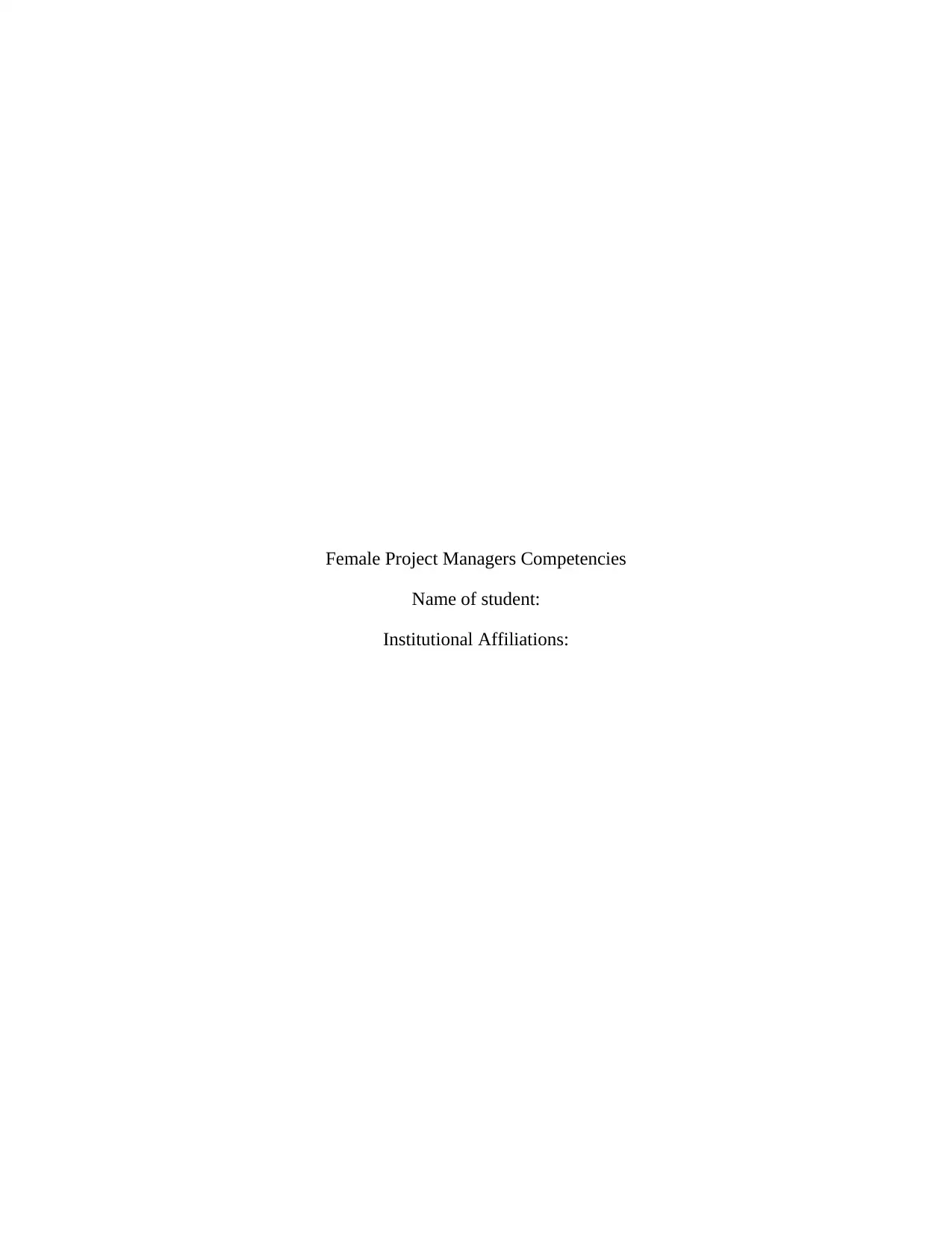
Female Project Managers Competencies
Name of student:
Institutional Affiliations:
Name of student:
Institutional Affiliations:
Paraphrase This Document
Need a fresh take? Get an instant paraphrase of this document with our AI Paraphraser
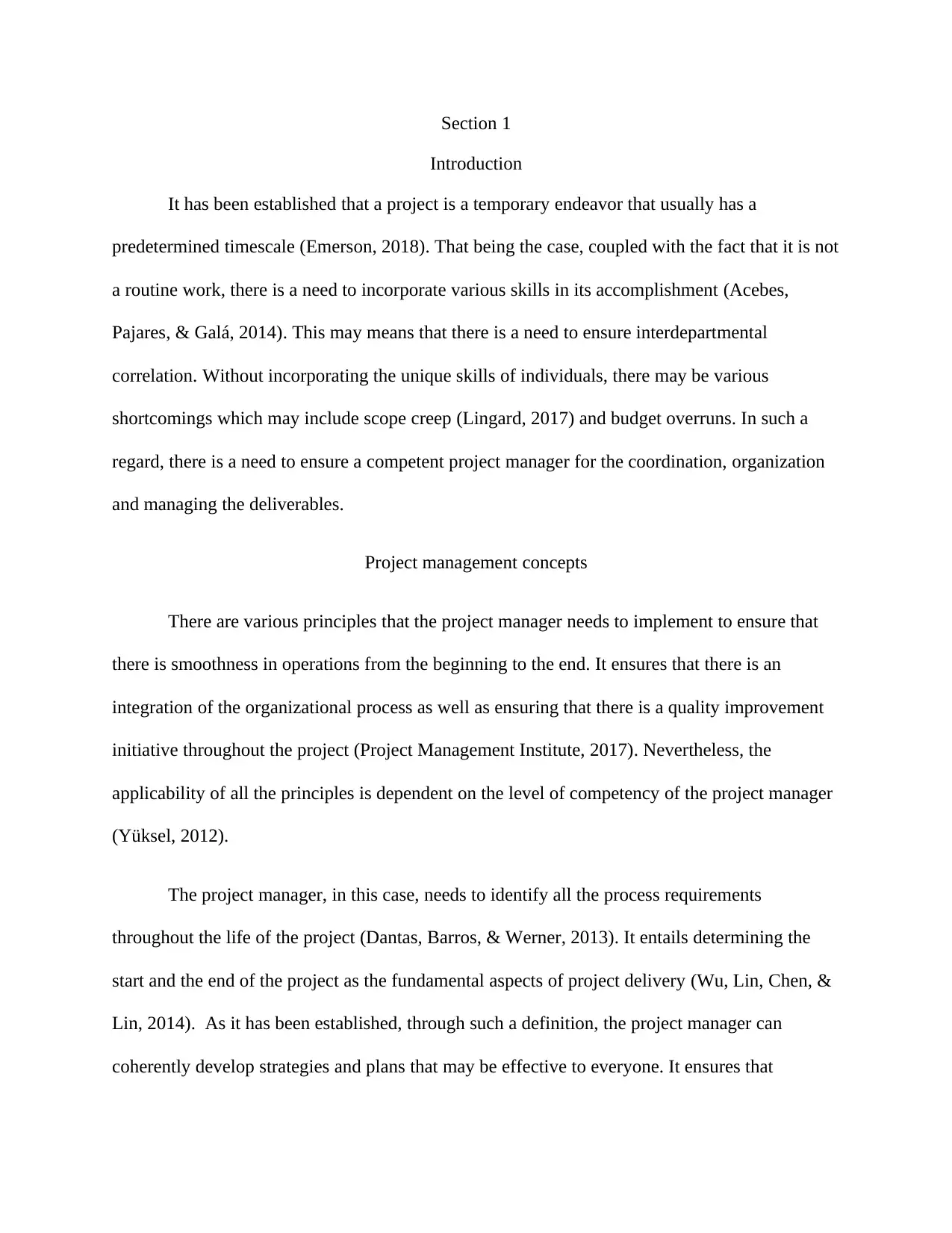
Section 1
Introduction
It has been established that a project is a temporary endeavor that usually has a
predetermined timescale (Emerson, 2018). That being the case, coupled with the fact that it is not
a routine work, there is a need to incorporate various skills in its accomplishment (Acebes,
Pajares, & Galá, 2014). This may means that there is a need to ensure interdepartmental
correlation. Without incorporating the unique skills of individuals, there may be various
shortcomings which may include scope creep (Lingard, 2017) and budget overruns. In such a
regard, there is a need to ensure a competent project manager for the coordination, organization
and managing the deliverables.
Project management concepts
There are various principles that the project manager needs to implement to ensure that
there is smoothness in operations from the beginning to the end. It ensures that there is an
integration of the organizational process as well as ensuring that there is a quality improvement
initiative throughout the project (Project Management Institute, 2017). Nevertheless, the
applicability of all the principles is dependent on the level of competency of the project manager
(Yüksel, 2012).
The project manager, in this case, needs to identify all the process requirements
throughout the life of the project (Dantas, Barros, & Werner, 2013). It entails determining the
start and the end of the project as the fundamental aspects of project delivery (Wu, Lin, Chen, &
Lin, 2014). As it has been established, through such a definition, the project manager can
coherently develop strategies and plans that may be effective to everyone. It ensures that
Introduction
It has been established that a project is a temporary endeavor that usually has a
predetermined timescale (Emerson, 2018). That being the case, coupled with the fact that it is not
a routine work, there is a need to incorporate various skills in its accomplishment (Acebes,
Pajares, & Galá, 2014). This may means that there is a need to ensure interdepartmental
correlation. Without incorporating the unique skills of individuals, there may be various
shortcomings which may include scope creep (Lingard, 2017) and budget overruns. In such a
regard, there is a need to ensure a competent project manager for the coordination, organization
and managing the deliverables.
Project management concepts
There are various principles that the project manager needs to implement to ensure that
there is smoothness in operations from the beginning to the end. It ensures that there is an
integration of the organizational process as well as ensuring that there is a quality improvement
initiative throughout the project (Project Management Institute, 2017). Nevertheless, the
applicability of all the principles is dependent on the level of competency of the project manager
(Yüksel, 2012).
The project manager, in this case, needs to identify all the process requirements
throughout the life of the project (Dantas, Barros, & Werner, 2013). It entails determining the
start and the end of the project as the fundamental aspects of project delivery (Wu, Lin, Chen, &
Lin, 2014). As it has been established, through such a definition, the project manager can
coherently develop strategies and plans that may be effective to everyone. It ensures that
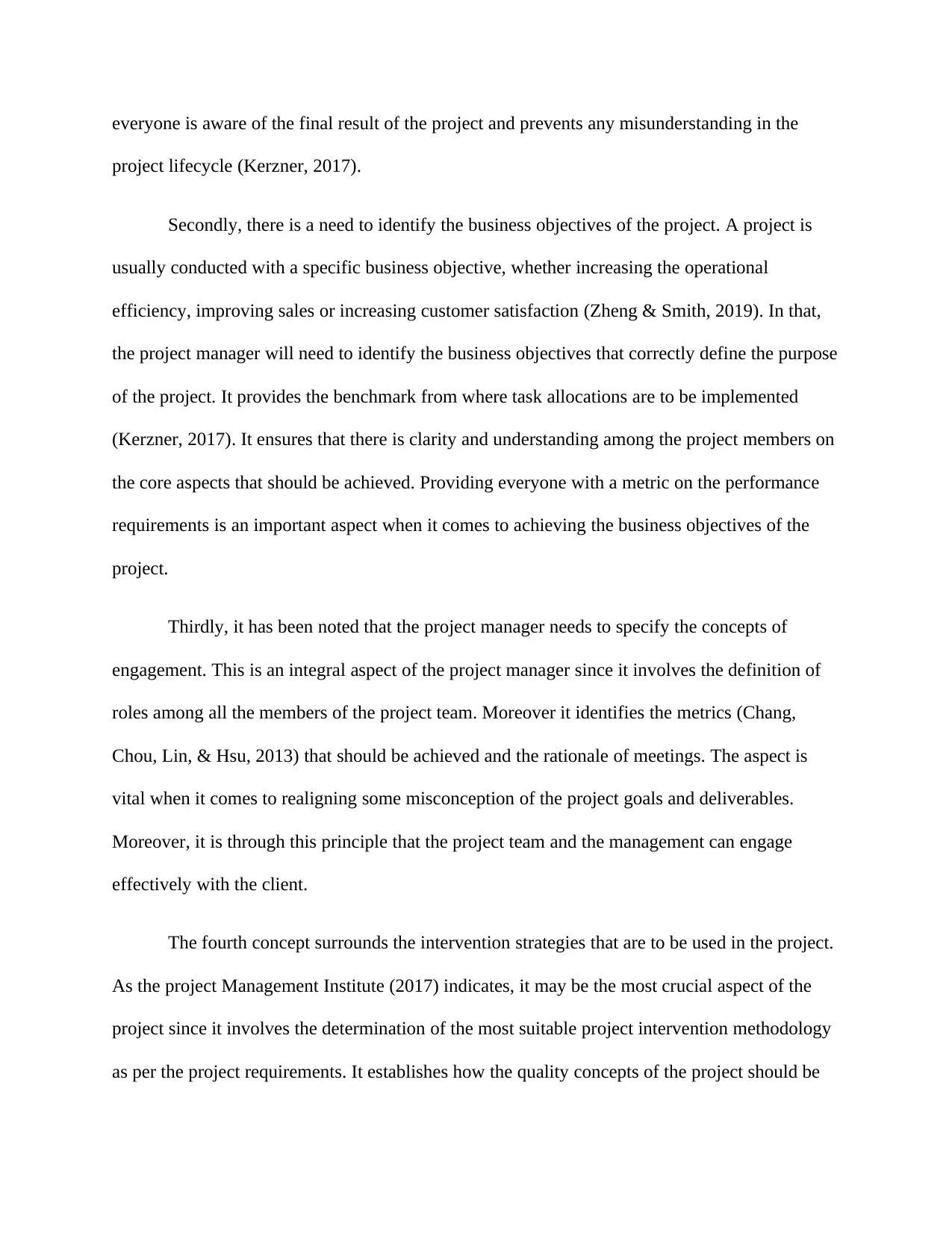
everyone is aware of the final result of the project and prevents any misunderstanding in the
project lifecycle (Kerzner, 2017).
Secondly, there is a need to identify the business objectives of the project. A project is
usually conducted with a specific business objective, whether increasing the operational
efficiency, improving sales or increasing customer satisfaction (Zheng & Smith, 2019). In that,
the project manager will need to identify the business objectives that correctly define the purpose
of the project. It provides the benchmark from where task allocations are to be implemented
(Kerzner, 2017). It ensures that there is clarity and understanding among the project members on
the core aspects that should be achieved. Providing everyone with a metric on the performance
requirements is an important aspect when it comes to achieving the business objectives of the
project.
Thirdly, it has been noted that the project manager needs to specify the concepts of
engagement. This is an integral aspect of the project manager since it involves the definition of
roles among all the members of the project team. Moreover it identifies the metrics (Chang,
Chou, Lin, & Hsu, 2013) that should be achieved and the rationale of meetings. The aspect is
vital when it comes to realigning some misconception of the project goals and deliverables.
Moreover, it is through this principle that the project team and the management can engage
effectively with the client.
The fourth concept surrounds the intervention strategies that are to be used in the project.
As the project Management Institute (2017) indicates, it may be the most crucial aspect of the
project since it involves the determination of the most suitable project intervention methodology
as per the project requirements. It establishes how the quality concepts of the project should be
project lifecycle (Kerzner, 2017).
Secondly, there is a need to identify the business objectives of the project. A project is
usually conducted with a specific business objective, whether increasing the operational
efficiency, improving sales or increasing customer satisfaction (Zheng & Smith, 2019). In that,
the project manager will need to identify the business objectives that correctly define the purpose
of the project. It provides the benchmark from where task allocations are to be implemented
(Kerzner, 2017). It ensures that there is clarity and understanding among the project members on
the core aspects that should be achieved. Providing everyone with a metric on the performance
requirements is an important aspect when it comes to achieving the business objectives of the
project.
Thirdly, it has been noted that the project manager needs to specify the concepts of
engagement. This is an integral aspect of the project manager since it involves the definition of
roles among all the members of the project team. Moreover it identifies the metrics (Chang,
Chou, Lin, & Hsu, 2013) that should be achieved and the rationale of meetings. The aspect is
vital when it comes to realigning some misconception of the project goals and deliverables.
Moreover, it is through this principle that the project team and the management can engage
effectively with the client.
The fourth concept surrounds the intervention strategies that are to be used in the project.
As the project Management Institute (2017) indicates, it may be the most crucial aspect of the
project since it involves the determination of the most suitable project intervention methodology
as per the project requirements. It establishes how the quality concepts of the project should be
⊘ This is a preview!⊘
Do you want full access?
Subscribe today to unlock all pages.

Trusted by 1+ million students worldwide
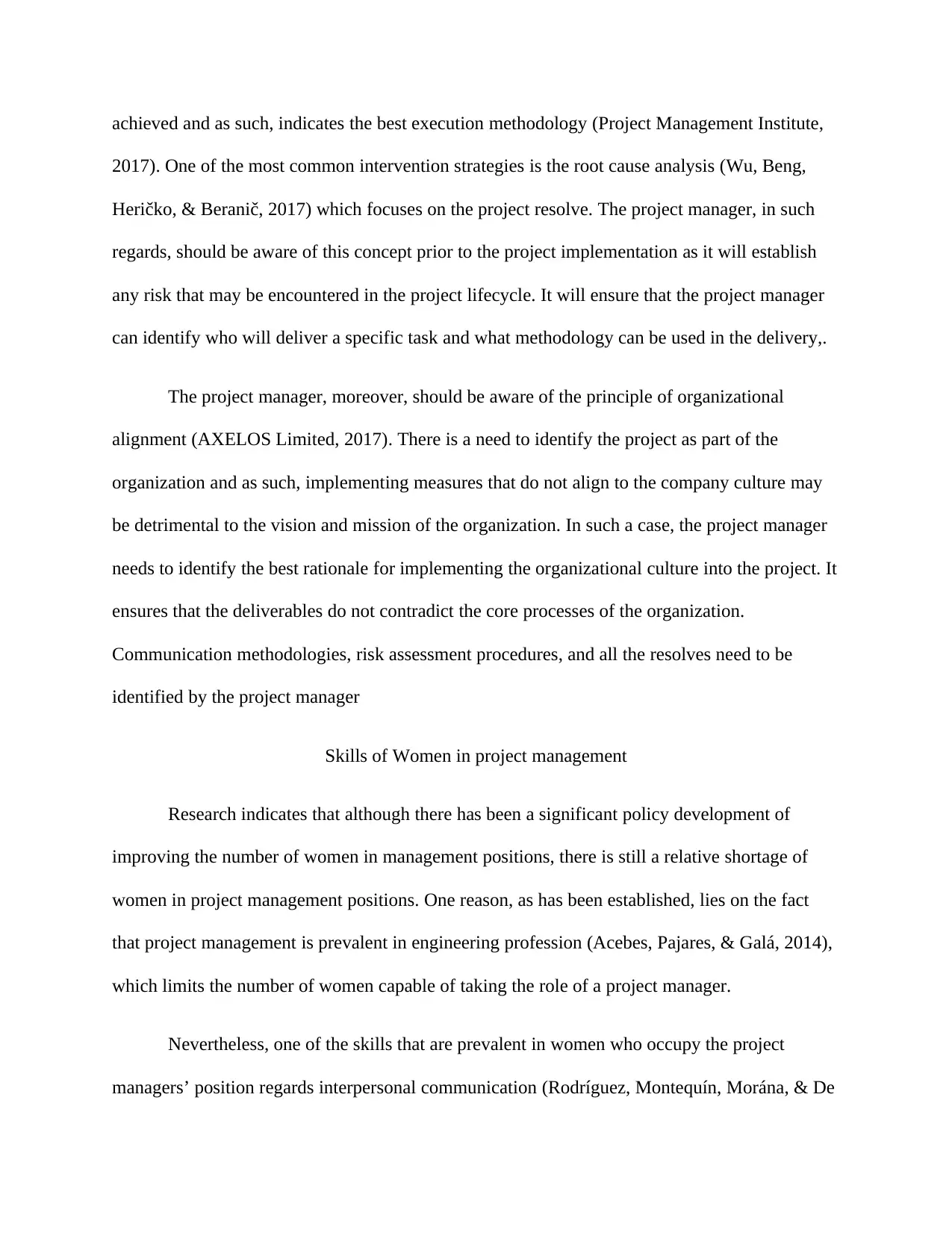
achieved and as such, indicates the best execution methodology (Project Management Institute,
2017). One of the most common intervention strategies is the root cause analysis (Wu, Beng,
Heričko, & Beranič, 2017) which focuses on the project resolve. The project manager, in such
regards, should be aware of this concept prior to the project implementation as it will establish
any risk that may be encountered in the project lifecycle. It will ensure that the project manager
can identify who will deliver a specific task and what methodology can be used in the delivery,.
The project manager, moreover, should be aware of the principle of organizational
alignment (AXELOS Limited, 2017). There is a need to identify the project as part of the
organization and as such, implementing measures that do not align to the company culture may
be detrimental to the vision and mission of the organization. In such a case, the project manager
needs to identify the best rationale for implementing the organizational culture into the project. It
ensures that the deliverables do not contradict the core processes of the organization.
Communication methodologies, risk assessment procedures, and all the resolves need to be
identified by the project manager
Skills of Women in project management
Research indicates that although there has been a significant policy development of
improving the number of women in management positions, there is still a relative shortage of
women in project management positions. One reason, as has been established, lies on the fact
that project management is prevalent in engineering profession (Acebes, Pajares, & Galá, 2014),
which limits the number of women capable of taking the role of a project manager.
Nevertheless, one of the skills that are prevalent in women who occupy the project
managers’ position regards interpersonal communication (Rodríguez, Montequín, Morána, & De
2017). One of the most common intervention strategies is the root cause analysis (Wu, Beng,
Heričko, & Beranič, 2017) which focuses on the project resolve. The project manager, in such
regards, should be aware of this concept prior to the project implementation as it will establish
any risk that may be encountered in the project lifecycle. It will ensure that the project manager
can identify who will deliver a specific task and what methodology can be used in the delivery,.
The project manager, moreover, should be aware of the principle of organizational
alignment (AXELOS Limited, 2017). There is a need to identify the project as part of the
organization and as such, implementing measures that do not align to the company culture may
be detrimental to the vision and mission of the organization. In such a case, the project manager
needs to identify the best rationale for implementing the organizational culture into the project. It
ensures that the deliverables do not contradict the core processes of the organization.
Communication methodologies, risk assessment procedures, and all the resolves need to be
identified by the project manager
Skills of Women in project management
Research indicates that although there has been a significant policy development of
improving the number of women in management positions, there is still a relative shortage of
women in project management positions. One reason, as has been established, lies on the fact
that project management is prevalent in engineering profession (Acebes, Pajares, & Galá, 2014),
which limits the number of women capable of taking the role of a project manager.
Nevertheless, one of the skills that are prevalent in women who occupy the project
managers’ position regards interpersonal communication (Rodríguez, Montequín, Morána, & De
Paraphrase This Document
Need a fresh take? Get an instant paraphrase of this document with our AI Paraphraser
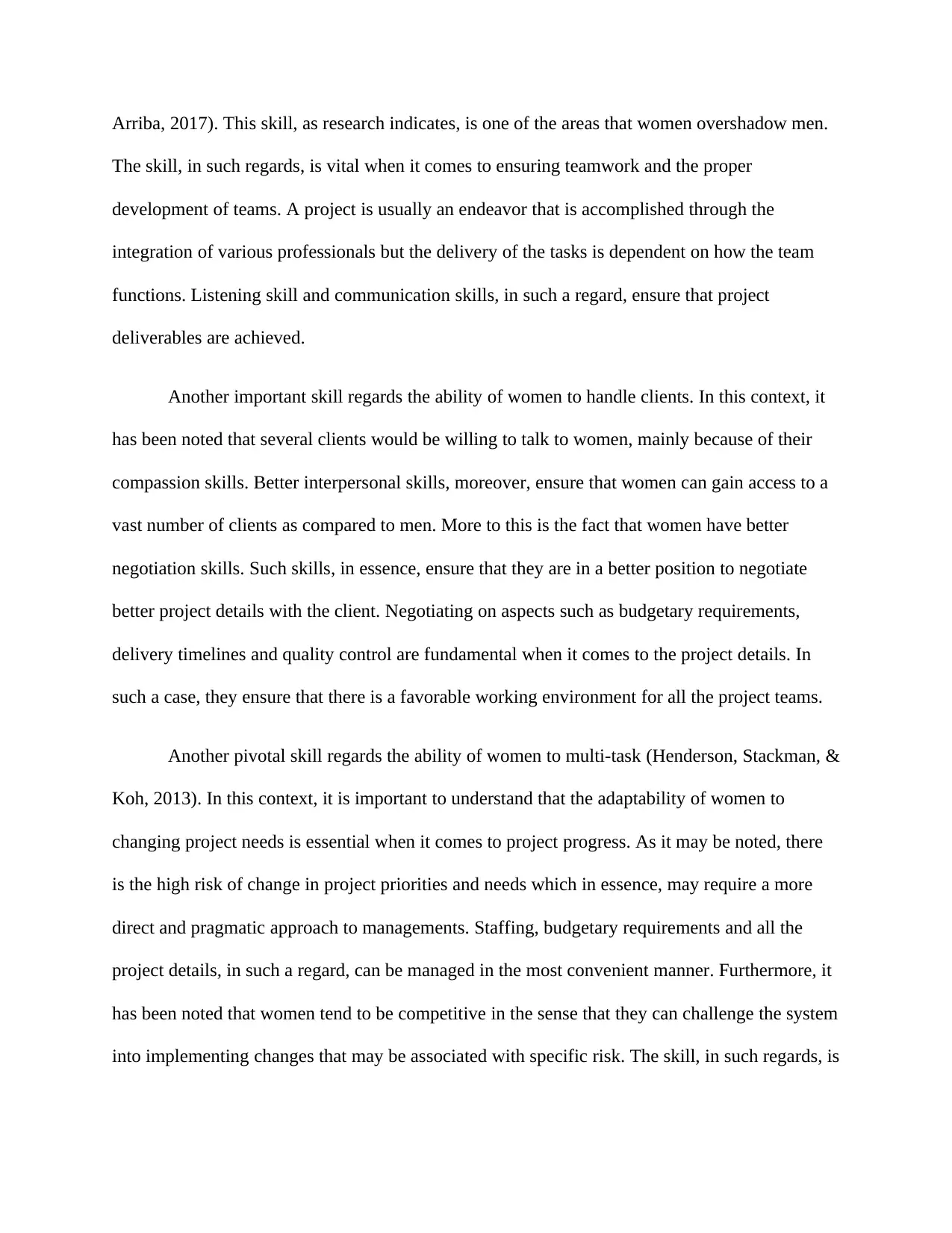
Arriba, 2017). This skill, as research indicates, is one of the areas that women overshadow men.
The skill, in such regards, is vital when it comes to ensuring teamwork and the proper
development of teams. A project is usually an endeavor that is accomplished through the
integration of various professionals but the delivery of the tasks is dependent on how the team
functions. Listening skill and communication skills, in such a regard, ensure that project
deliverables are achieved.
Another important skill regards the ability of women to handle clients. In this context, it
has been noted that several clients would be willing to talk to women, mainly because of their
compassion skills. Better interpersonal skills, moreover, ensure that women can gain access to a
vast number of clients as compared to men. More to this is the fact that women have better
negotiation skills. Such skills, in essence, ensure that they are in a better position to negotiate
better project details with the client. Negotiating on aspects such as budgetary requirements,
delivery timelines and quality control are fundamental when it comes to the project details. In
such a case, they ensure that there is a favorable working environment for all the project teams.
Another pivotal skill regards the ability of women to multi-task (Henderson, Stackman, &
Koh, 2013). In this context, it is important to understand that the adaptability of women to
changing project needs is essential when it comes to project progress. As it may be noted, there
is the high risk of change in project priorities and needs which in essence, may require a more
direct and pragmatic approach to managements. Staffing, budgetary requirements and all the
project details, in such a regard, can be managed in the most convenient manner. Furthermore, it
has been noted that women tend to be competitive in the sense that they can challenge the system
into implementing changes that may be associated with specific risk. The skill, in such regards, is
The skill, in such regards, is vital when it comes to ensuring teamwork and the proper
development of teams. A project is usually an endeavor that is accomplished through the
integration of various professionals but the delivery of the tasks is dependent on how the team
functions. Listening skill and communication skills, in such a regard, ensure that project
deliverables are achieved.
Another important skill regards the ability of women to handle clients. In this context, it
has been noted that several clients would be willing to talk to women, mainly because of their
compassion skills. Better interpersonal skills, moreover, ensure that women can gain access to a
vast number of clients as compared to men. More to this is the fact that women have better
negotiation skills. Such skills, in essence, ensure that they are in a better position to negotiate
better project details with the client. Negotiating on aspects such as budgetary requirements,
delivery timelines and quality control are fundamental when it comes to the project details. In
such a case, they ensure that there is a favorable working environment for all the project teams.
Another pivotal skill regards the ability of women to multi-task (Henderson, Stackman, &
Koh, 2013). In this context, it is important to understand that the adaptability of women to
changing project needs is essential when it comes to project progress. As it may be noted, there
is the high risk of change in project priorities and needs which in essence, may require a more
direct and pragmatic approach to managements. Staffing, budgetary requirements and all the
project details, in such a regard, can be managed in the most convenient manner. Furthermore, it
has been noted that women tend to be competitive in the sense that they can challenge the system
into implementing changes that may be associated with specific risk. The skill, in such regards, is
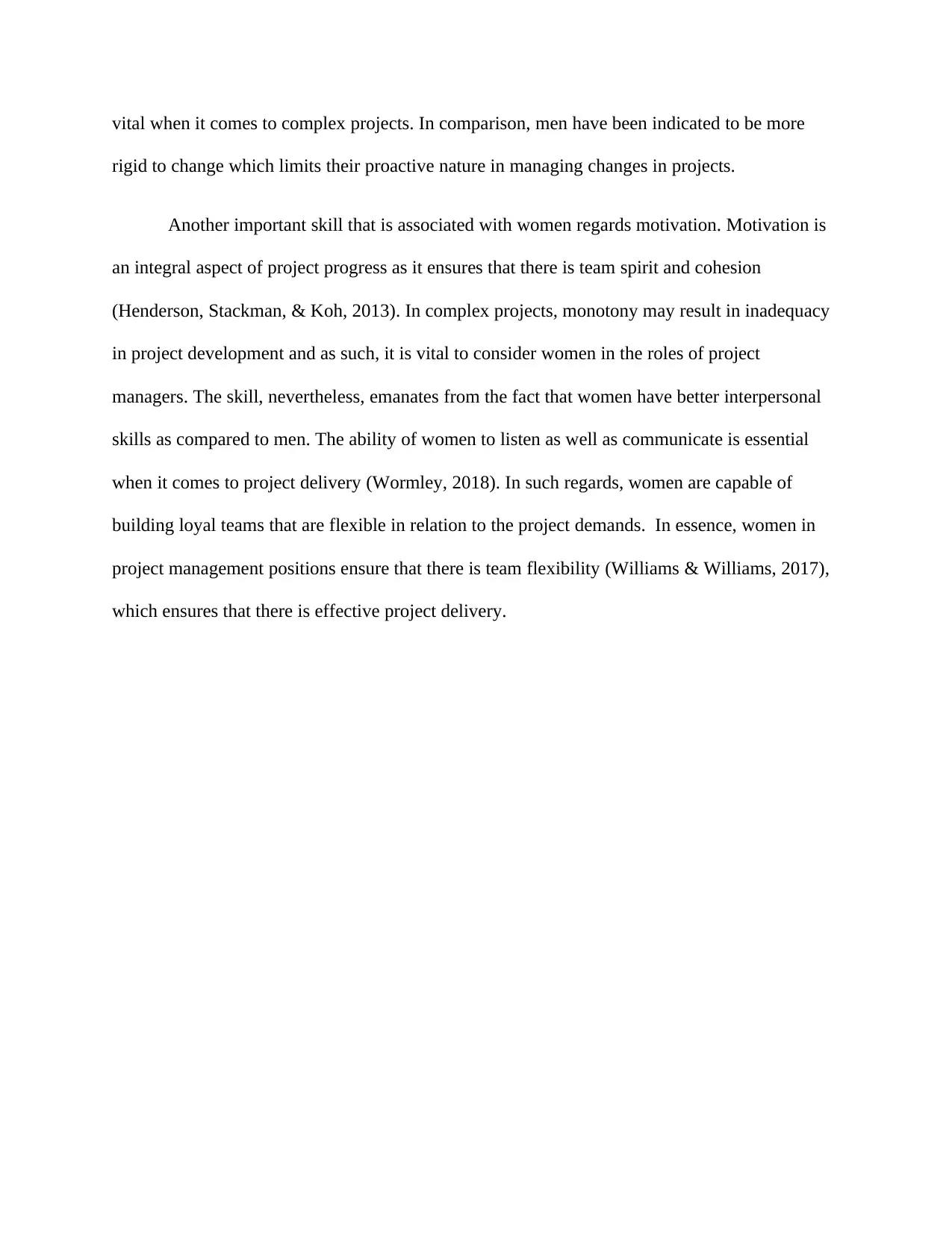
vital when it comes to complex projects. In comparison, men have been indicated to be more
rigid to change which limits their proactive nature in managing changes in projects.
Another important skill that is associated with women regards motivation. Motivation is
an integral aspect of project progress as it ensures that there is team spirit and cohesion
(Henderson, Stackman, & Koh, 2013). In complex projects, monotony may result in inadequacy
in project development and as such, it is vital to consider women in the roles of project
managers. The skill, nevertheless, emanates from the fact that women have better interpersonal
skills as compared to men. The ability of women to listen as well as communicate is essential
when it comes to project delivery (Wormley, 2018). In such regards, women are capable of
building loyal teams that are flexible in relation to the project demands. In essence, women in
project management positions ensure that there is team flexibility (Williams & Williams, 2017),
which ensures that there is effective project delivery.
rigid to change which limits their proactive nature in managing changes in projects.
Another important skill that is associated with women regards motivation. Motivation is
an integral aspect of project progress as it ensures that there is team spirit and cohesion
(Henderson, Stackman, & Koh, 2013). In complex projects, monotony may result in inadequacy
in project development and as such, it is vital to consider women in the roles of project
managers. The skill, nevertheless, emanates from the fact that women have better interpersonal
skills as compared to men. The ability of women to listen as well as communicate is essential
when it comes to project delivery (Wormley, 2018). In such regards, women are capable of
building loyal teams that are flexible in relation to the project demands. In essence, women in
project management positions ensure that there is team flexibility (Williams & Williams, 2017),
which ensures that there is effective project delivery.
⊘ This is a preview!⊘
Do you want full access?
Subscribe today to unlock all pages.

Trusted by 1+ million students worldwide
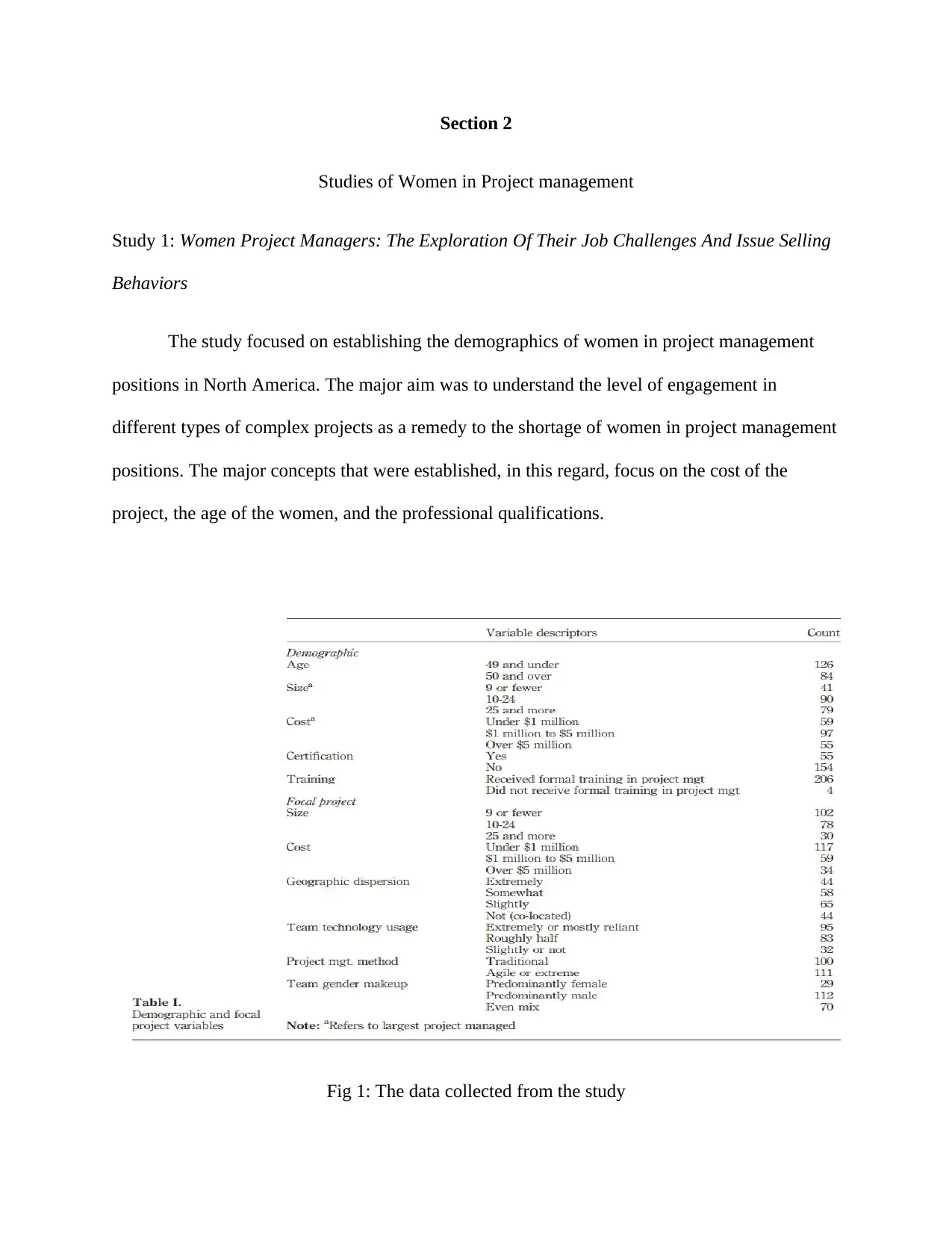
Section 2
Studies of Women in Project management
Study 1: Women Project Managers: The Exploration Of Their Job Challenges And Issue Selling
Behaviors
The study focused on establishing the demographics of women in project management
positions in North America. The major aim was to understand the level of engagement in
different types of complex projects as a remedy to the shortage of women in project management
positions. The major concepts that were established, in this regard, focus on the cost of the
project, the age of the women, and the professional qualifications.
Fig 1: The data collected from the study
Studies of Women in Project management
Study 1: Women Project Managers: The Exploration Of Their Job Challenges And Issue Selling
Behaviors
The study focused on establishing the demographics of women in project management
positions in North America. The major aim was to understand the level of engagement in
different types of complex projects as a remedy to the shortage of women in project management
positions. The major concepts that were established, in this regard, focus on the cost of the
project, the age of the women, and the professional qualifications.
Fig 1: The data collected from the study
Paraphrase This Document
Need a fresh take? Get an instant paraphrase of this document with our AI Paraphraser
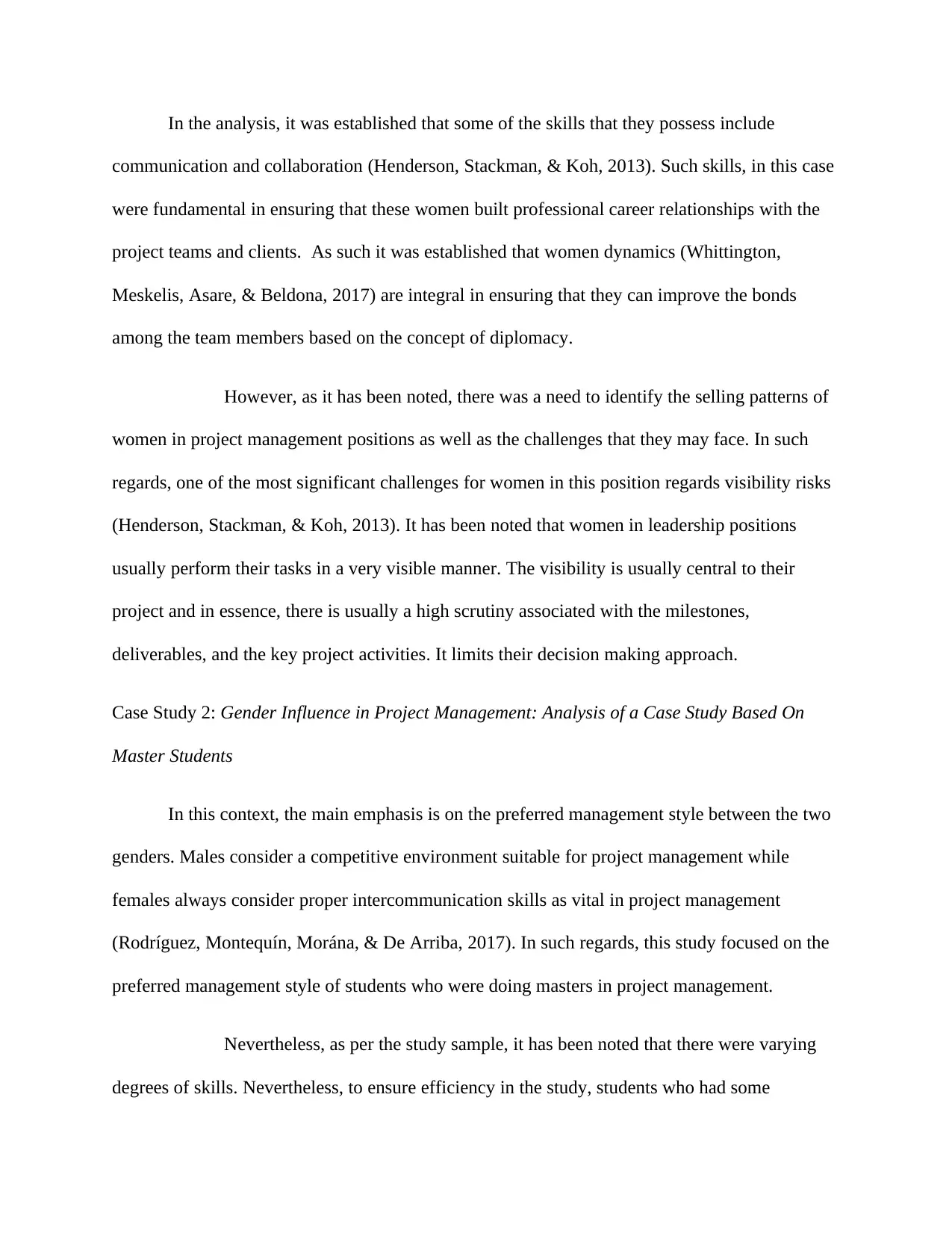
In the analysis, it was established that some of the skills that they possess include
communication and collaboration (Henderson, Stackman, & Koh, 2013). Such skills, in this case
were fundamental in ensuring that these women built professional career relationships with the
project teams and clients. As such it was established that women dynamics (Whittington,
Meskelis, Asare, & Beldona, 2017) are integral in ensuring that they can improve the bonds
among the team members based on the concept of diplomacy.
However, as it has been noted, there was a need to identify the selling patterns of
women in project management positions as well as the challenges that they may face. In such
regards, one of the most significant challenges for women in this position regards visibility risks
(Henderson, Stackman, & Koh, 2013). It has been noted that women in leadership positions
usually perform their tasks in a very visible manner. The visibility is usually central to their
project and in essence, there is usually a high scrutiny associated with the milestones,
deliverables, and the key project activities. It limits their decision making approach.
Case Study 2: Gender Influence in Project Management: Analysis of a Case Study Based On
Master Students
In this context, the main emphasis is on the preferred management style between the two
genders. Males consider a competitive environment suitable for project management while
females always consider proper intercommunication skills as vital in project management
(Rodríguez, Montequín, Morána, & De Arriba, 2017). In such regards, this study focused on the
preferred management style of students who were doing masters in project management.
Nevertheless, as per the study sample, it has been noted that there were varying
degrees of skills. Nevertheless, to ensure efficiency in the study, students who had some
communication and collaboration (Henderson, Stackman, & Koh, 2013). Such skills, in this case
were fundamental in ensuring that these women built professional career relationships with the
project teams and clients. As such it was established that women dynamics (Whittington,
Meskelis, Asare, & Beldona, 2017) are integral in ensuring that they can improve the bonds
among the team members based on the concept of diplomacy.
However, as it has been noted, there was a need to identify the selling patterns of
women in project management positions as well as the challenges that they may face. In such
regards, one of the most significant challenges for women in this position regards visibility risks
(Henderson, Stackman, & Koh, 2013). It has been noted that women in leadership positions
usually perform their tasks in a very visible manner. The visibility is usually central to their
project and in essence, there is usually a high scrutiny associated with the milestones,
deliverables, and the key project activities. It limits their decision making approach.
Case Study 2: Gender Influence in Project Management: Analysis of a Case Study Based On
Master Students
In this context, the main emphasis is on the preferred management style between the two
genders. Males consider a competitive environment suitable for project management while
females always consider proper intercommunication skills as vital in project management
(Rodríguez, Montequín, Morána, & De Arriba, 2017). In such regards, this study focused on the
preferred management style of students who were doing masters in project management.
Nevertheless, as per the study sample, it has been noted that there were varying
degrees of skills. Nevertheless, to ensure efficiency in the study, students who had some
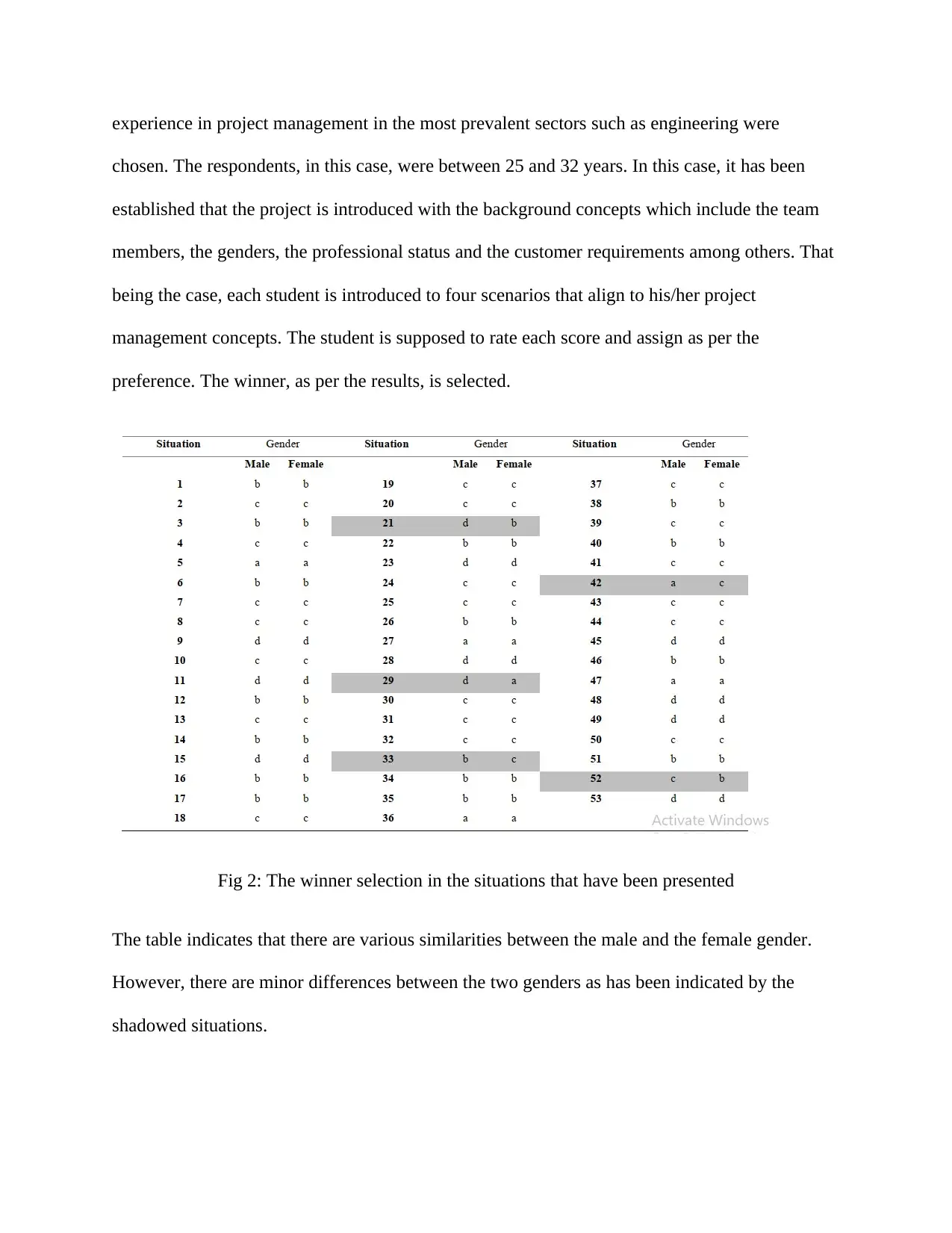
experience in project management in the most prevalent sectors such as engineering were
chosen. The respondents, in this case, were between 25 and 32 years. In this case, it has been
established that the project is introduced with the background concepts which include the team
members, the genders, the professional status and the customer requirements among others. That
being the case, each student is introduced to four scenarios that align to his/her project
management concepts. The student is supposed to rate each score and assign as per the
preference. The winner, as per the results, is selected.
Fig 2: The winner selection in the situations that have been presented
The table indicates that there are various similarities between the male and the female gender.
However, there are minor differences between the two genders as has been indicated by the
shadowed situations.
chosen. The respondents, in this case, were between 25 and 32 years. In this case, it has been
established that the project is introduced with the background concepts which include the team
members, the genders, the professional status and the customer requirements among others. That
being the case, each student is introduced to four scenarios that align to his/her project
management concepts. The student is supposed to rate each score and assign as per the
preference. The winner, as per the results, is selected.
Fig 2: The winner selection in the situations that have been presented
The table indicates that there are various similarities between the male and the female gender.
However, there are minor differences between the two genders as has been indicated by the
shadowed situations.
⊘ This is a preview!⊘
Do you want full access?
Subscribe today to unlock all pages.

Trusted by 1+ million students worldwide
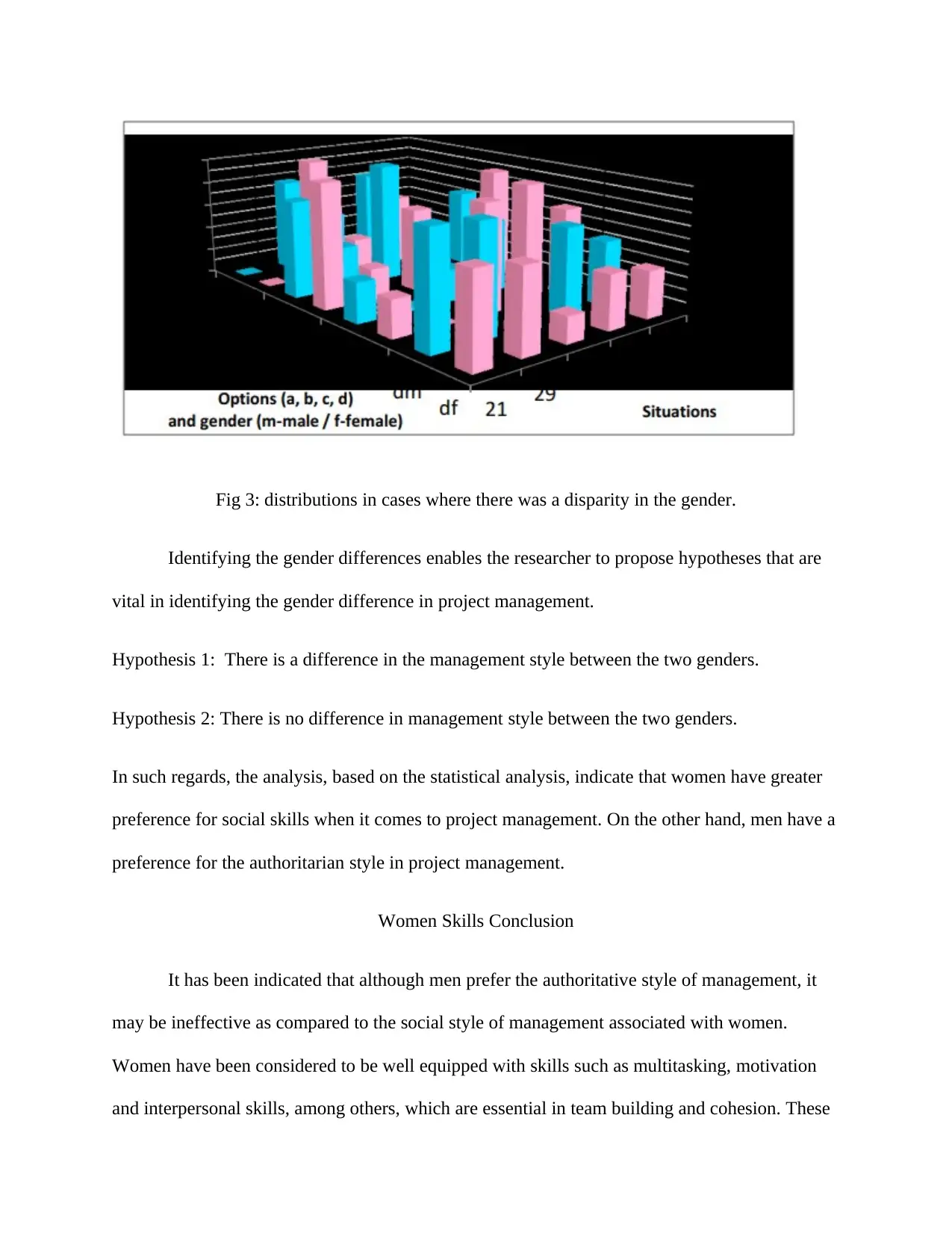
Fig 3: distributions in cases where there was a disparity in the gender.
Identifying the gender differences enables the researcher to propose hypotheses that are
vital in identifying the gender difference in project management.
Hypothesis 1: There is a difference in the management style between the two genders.
Hypothesis 2: There is no difference in management style between the two genders.
In such regards, the analysis, based on the statistical analysis, indicate that women have greater
preference for social skills when it comes to project management. On the other hand, men have a
preference for the authoritarian style in project management.
Women Skills Conclusion
It has been indicated that although men prefer the authoritative style of management, it
may be ineffective as compared to the social style of management associated with women.
Women have been considered to be well equipped with skills such as multitasking, motivation
and interpersonal skills, among others, which are essential in team building and cohesion. These
Identifying the gender differences enables the researcher to propose hypotheses that are
vital in identifying the gender difference in project management.
Hypothesis 1: There is a difference in the management style between the two genders.
Hypothesis 2: There is no difference in management style between the two genders.
In such regards, the analysis, based on the statistical analysis, indicate that women have greater
preference for social skills when it comes to project management. On the other hand, men have a
preference for the authoritarian style in project management.
Women Skills Conclusion
It has been indicated that although men prefer the authoritative style of management, it
may be ineffective as compared to the social style of management associated with women.
Women have been considered to be well equipped with skills such as multitasking, motivation
and interpersonal skills, among others, which are essential in team building and cohesion. These
Paraphrase This Document
Need a fresh take? Get an instant paraphrase of this document with our AI Paraphraser

skills are vital in ensuring that all the members of the team feel included, mainly through the
display of empathy and compassion towards each member. In essence, it is vital for any woman
in a project management position to be well acquainted with the principles of project
management as well as the phases of project to be successful.
References
display of empathy and compassion towards each member. In essence, it is vital for any woman
in a project management position to be well acquainted with the principles of project
management as well as the phases of project to be successful.
References
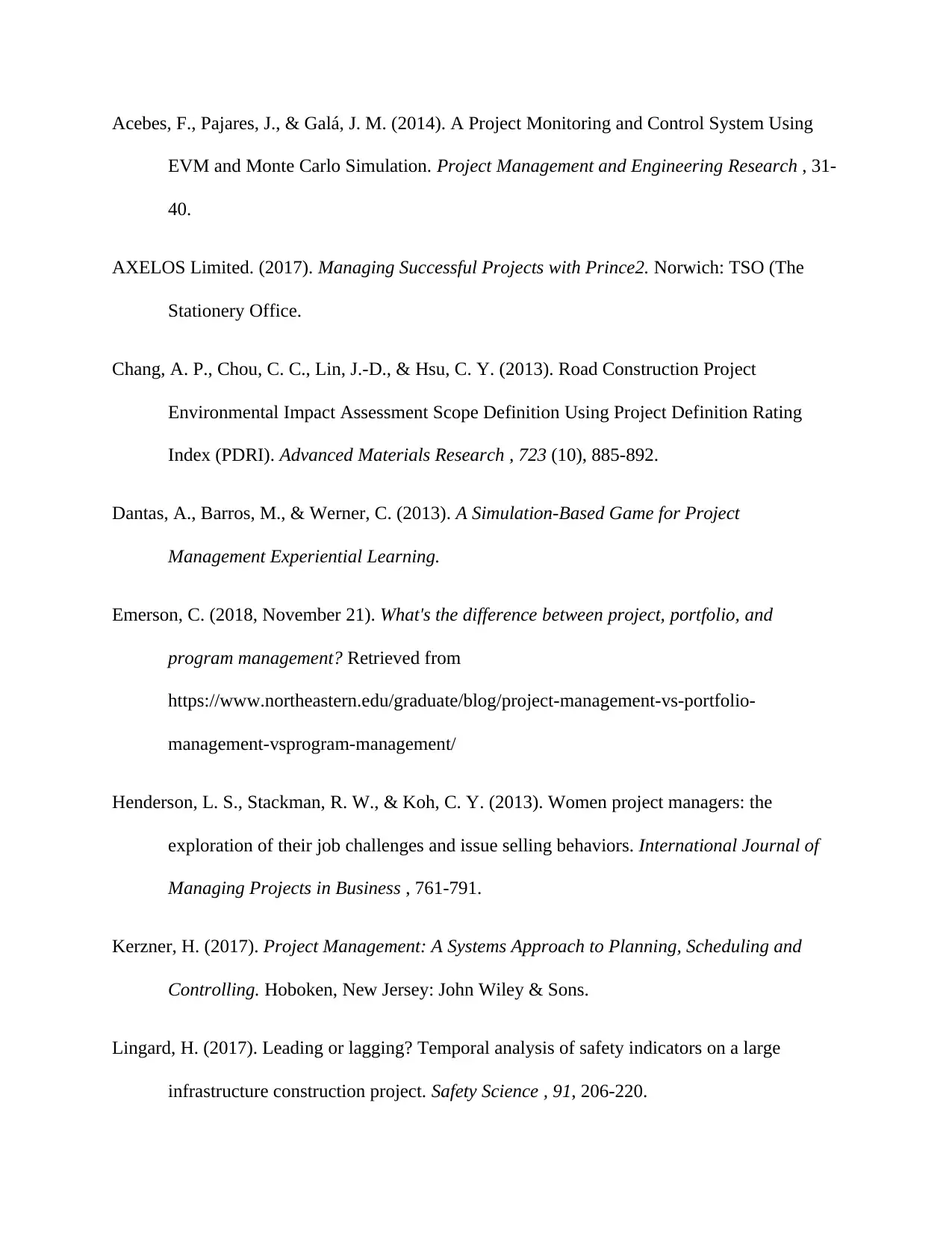
Acebes, F., Pajares, J., & Galá, J. M. (2014). A Project Monitoring and Control System Using
EVM and Monte Carlo Simulation. Project Management and Engineering Research , 31-
40.
AXELOS Limited. (2017). Managing Successful Projects with Prince2. Norwich: TSO (The
Stationery Office.
Chang, A. P., Chou, C. C., Lin, J.-D., & Hsu, C. Y. (2013). Road Construction Project
Environmental Impact Assessment Scope Definition Using Project Definition Rating
Index (PDRI). Advanced Materials Research , 723 (10), 885-892.
Dantas, A., Barros, M., & Werner, C. (2013). A Simulation-Based Game for Project
Management Experiential Learning.
Emerson, C. (2018, November 21). What's the difference between project, portfolio, and
program management? Retrieved from
https://www.northeastern.edu/graduate/blog/project-management-vs-portfolio-
management-vsprogram-management/
Henderson, L. S., Stackman, R. W., & Koh, C. Y. (2013). Women project managers: the
exploration of their job challenges and issue selling behaviors. International Journal of
Managing Projects in Business , 761-791.
Kerzner, H. (2017). Project Management: A Systems Approach to Planning, Scheduling and
Controlling. Hoboken, New Jersey: John Wiley & Sons.
Lingard, H. (2017). Leading or lagging? Temporal analysis of safety indicators on a large
infrastructure construction project. Safety Science , 91, 206-220.
EVM and Monte Carlo Simulation. Project Management and Engineering Research , 31-
40.
AXELOS Limited. (2017). Managing Successful Projects with Prince2. Norwich: TSO (The
Stationery Office.
Chang, A. P., Chou, C. C., Lin, J.-D., & Hsu, C. Y. (2013). Road Construction Project
Environmental Impact Assessment Scope Definition Using Project Definition Rating
Index (PDRI). Advanced Materials Research , 723 (10), 885-892.
Dantas, A., Barros, M., & Werner, C. (2013). A Simulation-Based Game for Project
Management Experiential Learning.
Emerson, C. (2018, November 21). What's the difference between project, portfolio, and
program management? Retrieved from
https://www.northeastern.edu/graduate/blog/project-management-vs-portfolio-
management-vsprogram-management/
Henderson, L. S., Stackman, R. W., & Koh, C. Y. (2013). Women project managers: the
exploration of their job challenges and issue selling behaviors. International Journal of
Managing Projects in Business , 761-791.
Kerzner, H. (2017). Project Management: A Systems Approach to Planning, Scheduling and
Controlling. Hoboken, New Jersey: John Wiley & Sons.
Lingard, H. (2017). Leading or lagging? Temporal analysis of safety indicators on a large
infrastructure construction project. Safety Science , 91, 206-220.
⊘ This is a preview!⊘
Do you want full access?
Subscribe today to unlock all pages.

Trusted by 1+ million students worldwide
1 out of 14
Related Documents
Your All-in-One AI-Powered Toolkit for Academic Success.
+13062052269
info@desklib.com
Available 24*7 on WhatsApp / Email
![[object Object]](/_next/static/media/star-bottom.7253800d.svg)
Unlock your academic potential
Copyright © 2020–2025 A2Z Services. All Rights Reserved. Developed and managed by ZUCOL.





